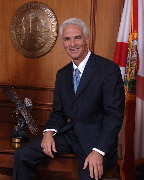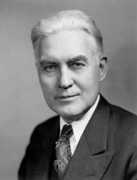Charlie Crist and the Long Odds of an Independent U.S. Senate Candidacy
Only six men have been elected to a first term in the U.S. Senate without major party backing since popular vote elections in 1914; only two have won running without any party label

Crist’s camp is buoyed no doubt that he has led in three of the four polls that have been conducted since his late-April announcement of his departure from the GOP between himself, likely Republican nominee Marco Rubio, and likely Democratic nominee Kendrick Meek.
The most recent poll, by the St. Petersburg Times/Miami Herald, had Crist at 30 percent, Rubio at 27 percent, Meek at 15 percent, with 23 percent still undecided.
However, a Smart Politics analysis of more than 1,500 U.S. Senate contests since 1914 finds that winning a U.S. Senate seat under Crist’s circumstances is almost unprecedented.
Since popular vote elections were introduced nearly 100 years ago, only two candidates have been elected to a first term in the U.S. Senate without running under a party label – third party or otherwise.
In total, 16 men have served in the U.S. Senate since 1914 for at least part of their tenure without affiliating themselves with the Democratic or Republican parties.
· Of these 16 Senators, two were never elected:
Farmer-Laborite Elmer Benson of Minnesota was appointed in 1935 and Independent Dean Barkley of Minnesota was appointed in 2002.
· Of the remaining 14 Senators, four were elected on a major party ticket, but switched their party affiliation in the middle of their term and were never elected to the U.S. Senate outside of the two-party system:
Vermont’s Jim Jeffords became an independent in 2001 (after being elected as a Republican in 2000), New Hampshire’s Bob Smith became an independent for a few months in 1999 (after being elected as a Republican in 1996), Oregon’s Wayne Morse became an independent in 1953 (after being elected as a Republican in 1950), and Washington’s Miles Poindexter became a Progressive in 1913 (after being elected as a Republican in 1910). Both Smith and Poindexter returned to the Republican Party later in the same term respectively.
· Of the remaining 10 Senators, four had previously been elected to the U.S. Senate under major party affiliation, thus making their ‘maverick’ U.S. Senate campaigns slightly easier than that of Crist’s because they were incumbents:
Connecticut’s Joe Lieberman was elected as a Democrat three times prior to his 2006 election as an independent. Virginia’s Harry Byrd was elected as a Democrat one time prior to his 1970 and 1976 victories as an independent. Nebraska’s George Norris was elected as a Republican four times prior to his 1936 victory as an independent. And Wisconsin’s Robert M. La Follette, Jr. was elected as a Republican two times prior to his 1934 and 1940 victories as a Progressive.
· That leaves six Senators who were elected to their first term in office outside of the major party system. Of these, four were elected with the backing of a third party:

Shipstead was elected three times as a Farmor-Laborite (1922, 1928, 1934) before running as a Republican in 1940. Johnson won a special election in 1923 and served almost two years, but was defeated by 1-point at the ballot box in 1924’s general election. Lundeen won Minnesota’s 1936 Senate race, serving until his death in 1940.
The fourth Senator to be elected exclusively on a third-party ticket was James Buckley of New York, winning one term under the Conservative Party of New York banner.
· That leaves just two U.S. Senators in nearly 100 years who have been elected to the U.S. Senate for their first term without running under a party label, which is what Crist is trying to accomplish in 2010: Vermont’s Bernie Sanders in 2006 and South Carolina’s Strom Thurmond in 1954.
Sanders’ seat was previously held by outgoing independent Jim Jeffords (Sanders also had the backing of key Democratic figures, but opted to decline the Democratic nomination), while Thurmond was elected as a write-in candidate in his first of two tenures in the U.S. Senate.
All told, out of the more than 1,600 popular vote general election U.S. Senate contests that will have been conducted from 1914 through the 2010 election, Crist is seeking to become:
· 1 of 11 U.S. Senators to have been elected while running outside of the two-party system.
· 1 of 7 U.S. Senators to have been elected outside of the two-party system for a first term in office.
· 1 of 3 U.S. Senators to have been elected for a first term in office without running on any party label.
Despite these long odds, Crist, of course, has several credits to his account – a recent statewide election victory and a current solid approval rating as Governor being chief among them.
And there is another noteworthy fact that a Senator Crist would bring to the institution.
If Crist should be elected this November, it will mark the first time since the 76th Congress (1939-1941) that three or more U.S. Senators will be serving at the same time without Republican or Democratic Party affiliation.
Since popular vote elections took root in 1914, there have only been parts of three Congresses in which there have been at least three Senators who were not Republicans or Democrats:
· The 74th Congress (3): Henrik Shipstead (Farmer-Labor, MN), Robert M. La Follette, Jr. (Progressive, WI), and, for 10 months, Elmer Benson (Farmer-Labor, MN).
· The 75th Congress (4): Shipstead, La Fallotte, George Norris (Independent, NE), and Ernest Lundeen (Farmer-Labor, MN)
· The 76th Congress (4): Shipstead, La Fallotte, Norris, and, for 1.75 years, Lundeen.
Follow Smart Politics on Twitter.
